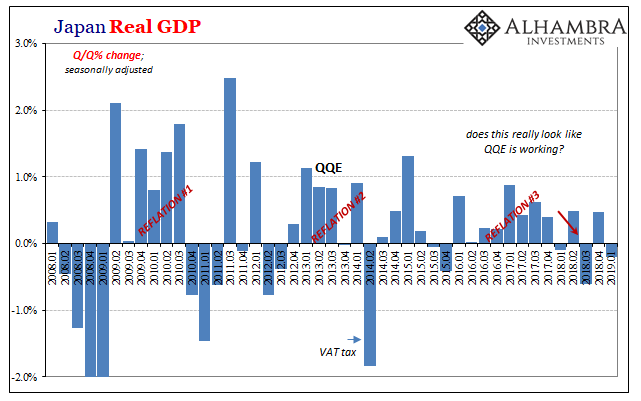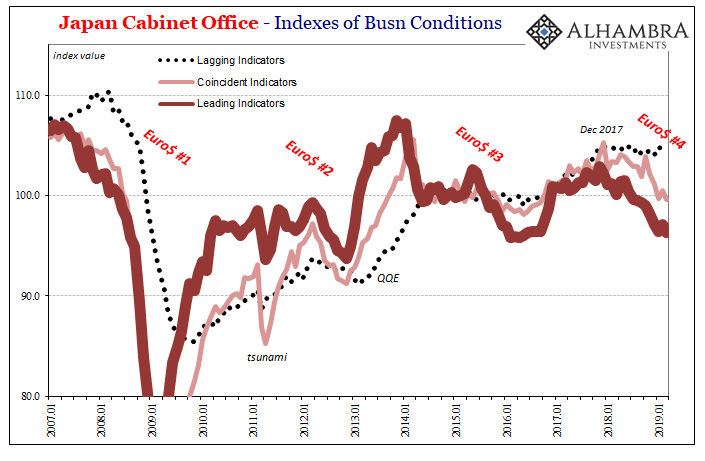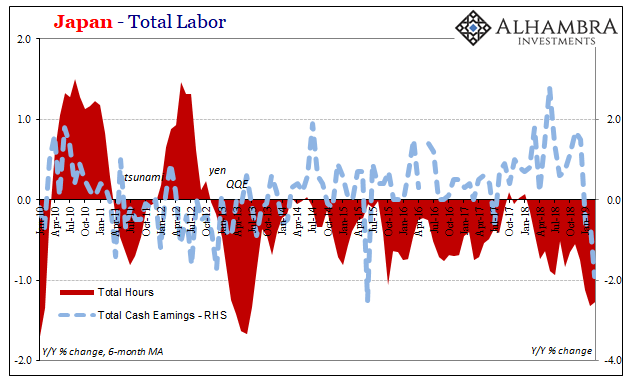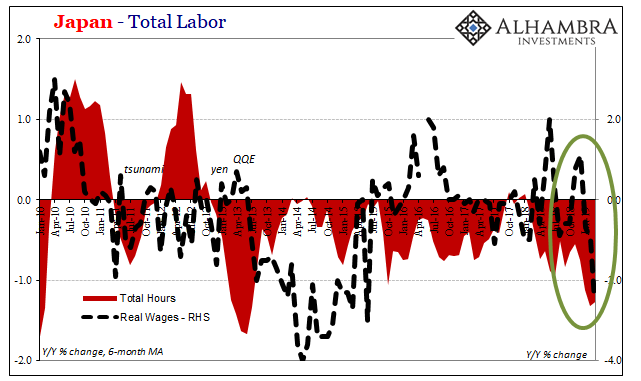For a lot of people, a recession is two consecutive quarters of negative GDP. This is called the technical definition in the mainstream and financial media. While this specific pattern can indicate a change in the business cycle, it’s really only one narrow case. Recessions are not just tied to GDP. In the US, the Economists who make the determination (the NBER) will tell you recessions aren’t always so straightforward. Everyone knew about the second half of the Great “Recession” because there wasn’t a data series, indication, or market price that wasn’t plummeting. The first half, though? It wasn’t until December 2008, more than two months after Lehman, that the NBER finally got around to “declaring” the United
Topics:
Jeffrey P. Snider considers the following as important: 5) Global Macro, Bank of Japan, cash earnings, China, currencies, economy, employment, Euro$ #4, EuroDollar, Featured, Federal Reserve/Monetary Policy, Japan, Labor market, Markets, nber, newsletter, QQE, real GDP, Recession, The United States, total hours worked, unemployment rate
This could be interesting, too:
RIA Team writes The Importance of Emergency Funds in Retirement Planning
Nachrichten Ticker - www.finanzen.ch writes Gesetzesvorschlag in Arizona: Wird Bitcoin bald zur Staatsreserve?
Nachrichten Ticker - www.finanzen.ch writes So bewegen sich Bitcoin & Co. heute
Nachrichten Ticker - www.finanzen.ch writes Aktueller Marktbericht zu Bitcoin & Co.
For a lot of people, a recession is two consecutive quarters of negative GDP. This is called the technical definition in the mainstream and financial media. While this specific pattern can indicate a change in the business cycle, it’s really only one narrow case. Recessions are not just tied to GDP.
In the US, the Economists who make the determination (the NBER) will tell you recessions aren’t always so straightforward. Everyone knew about the second half of the Great “Recession” because there wasn’t a data series, indication, or market price that wasn’t plummeting.
The first half, though? It wasn’t until December 2008, more than two months after Lehman, that the NBER finally got around to “declaring” the United States in recession. In the annals of obviousness, even the empty suits at the FOMC took comfort in the NBER’s misstep; they didn’t feel quite so alone in botching their view of the economy that year.
In 2001, a US recession was declared even though GDP never did decline in two straight quarters. According to the BEA’s latest numbers, domestic output fell in Q1 2001, rebounded in Q2 (by more than 2.3%), and then fell again in Q3. This isn’t actually unusual, as the NBER’s Business Cycle Dating Committee admits:
In both recessions and expansions, brief reversals in economic activity may occur – a recession may include a short period of expansion followed by further decline.
| Balance of probabilities, though, if GDP is only positive intermittently chances are much more so on the side of recession. An actual expansion, or boom, is one where weak perhaps negative quarters are not excluded but very few and far between. That’s what a boom is, consistent, sustained high growth. The GDP numbers should match.
Which brings us to the intersection of Japan and Euro$ #4. The country’s main statistical body will report preliminary estimates for Q1 2019 real GDP next week. Most expect the economy will have contracted (consensus -0.2% Q/Q) again last quarter. If it does, this will mean three out of the last five sporting minus signs. None of them consecutively. Maybe the Japanese economy isn’t (yet) in recession, but it sure isn’t growing which can only mean the risks are all tilted the opposite way. |
Japan Real GDP, 2008-2019 |
| Given that, the prospects for worse conditions keep piling up. That’s largely the point. Again, occasional growth is just not growth. If GDP rises in fits and starts for five quarters, more than anything this would suggest something deeply wrong, an increasing deviation from health.
It’s especially true when these results are posted so far against expectations – Japan was supposed to be truly booming in 2018 and 2019 for the first time in maybe three decades. Rather than monetary policy success, Japan’s struggle indicates only more and more the strangle of Euro$ #4. Central bankers and Economists have been proved quite mistaken about what actually happened in 2017. It may have been globally synchronized growth, it’s just that the term didn’t mean what it was supposed to have meant. It wasn’t actually a significant change from the prior decade. Euro$ #4 keeps on going. Now nearly a year and a half, Japan is still facing the prospects of recession anyway. The government’s Cabinet Office yesterday (thanks M. Simmons) downgraded the outlook to outright “worsening” based on leading, coincident, and lagging indicators through March 2019. Their previous position for February was, “a turning point towards a downgrade.” |
Japan Cabinet Office 2007-2019 |
| On that front, the Ministry of Health, Labour, and Welfare delivered some sobering news last week. Preliminary estimates for the month of March 2019 showed some disturbing signs of pretty severe weakness in Japan’s labor market.
As usual, it has little to do with the unemployment rate. Total Cash Earnings, a proxy for wages and salaries, has declined in each of the three months of 2019 where data is available. It’s the first time that’s happened since the end of 2013. Not only that, the contraction has gotten bigger each successive time. In March, Total Cash Earnings fell by 1.9% year-over-year, the second worst decline in the past decade. |
Japan Total Labor 2010-2019 |
| The reason? Total Hours worked really slumped. Japanese labor is in a secular decline anyway, but as you can see above and below it really accelerated to the downside starting in December 2018. More evidence the global economy struck a landmine at some point between September and the end of last year.
This is labor deflation. Japanese businesses are actively cutting hours, cutting pay, and even cutting wages. In short, Euro$ #4 in Japan isn’t proving to be a short disturbance. On the contrary, it is still picking up right where the latest global hopes have been pinned. After the shocking events of October, November, and December, the mainstream narrative shifted off the “strong” global economy into “rescue by doves.” Stubborn central bankers from Europe to the US to Japan finally admitted they were wrong about 2018, and then promised things would be different in 2019. They are different, only the wrong way. This first phase of “dovishness” including Japanese trial balloons for expanding (rather than ending) QQE just hasn’t worked. The way forward is still downward. |
Japan Total Labor 2010-2019 |
Japan is a leading indicator for global trade, and with little else moving the global economy, whichever way for global trade determines the direction for the worldwide system. As such, this economy shows that it is Euro$ #4 not trade wars behind the still-tightening economic squeeze.
Perhaps the next two quarters of Japanese real GDP will be negative. Maybe neither will. Whether or not that will be the case there’s already a whole lot that’s becoming recessionary in this one economy. This whole global economy.
Tags: Bank of Japan,cash earnings,currencies,economy,employment,Euro$ #4,EuroDollar,Featured,Federal Reserve/Monetary Policy,Japan,Labor Market,Markets,nber,newsletter,QQE,real GDP,recession,total hours worked,unemployment rate




